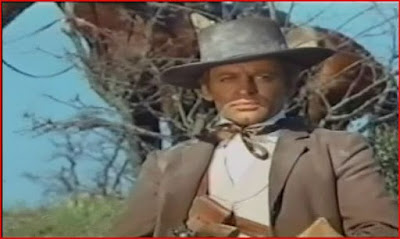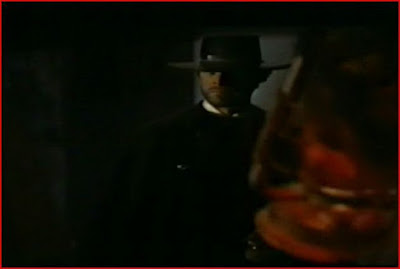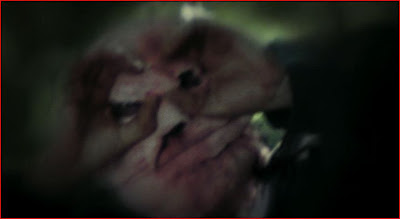 A few months ago I caught half of the William Wellman films included in Warner Home Video's Forbidden Hollywood Vol. 3 box set when TCM ran them all. A couple of weeks ago I finally broke down and bought the set because I thought the three I saw were pretty good and the others sounded promising. I was most interested in Wellman's film about the plight of war veterans, which stands in retrospect as a kind of companion piece to his youth-on-the-bum picture of the same year, Wild Boys of the Road. There's one important difference, however. Wild Boys is all about the Depression, while Heroes For Sale is set mostly in the 1920s -- and therein lies its particular message.
A few months ago I caught half of the William Wellman films included in Warner Home Video's Forbidden Hollywood Vol. 3 box set when TCM ran them all. A couple of weeks ago I finally broke down and bought the set because I thought the three I saw were pretty good and the others sounded promising. I was most interested in Wellman's film about the plight of war veterans, which stands in retrospect as a kind of companion piece to his youth-on-the-bum picture of the same year, Wild Boys of the Road. There's one important difference, however. Wild Boys is all about the Depression, while Heroes For Sale is set mostly in the 1920s -- and therein lies its particular message.People in 1933 might already have begun idealizing the 1920s as a golden age compared with their present plight. Wellman and screenwriters Robert Lord and Wilson Mizner are out to set them straight. They follow the adventures of Thomas Holmes (Richard Barthelmess), a soldier in World War I, and his buddy Roger Winston (Gordon Westcott), his social superior in their home town. They're sent out on a dangerous mission with Roger in command, but Roger screams and chickens out under machine gun fire as a dead body falls on top of him. Cursing Roger out as a "dirty yellow son of a b--," Tom accomplishes the mission but gets hit in the back with shrapnel. Figuring himself finished, he turns his prisoner over to Roger who, presuming the same, leaves Tom for dead.
Roger is instantly declared a hero by his comrades. He tries to tell the truth, but he's too weak-willed to assert himself. Meanwhile, the Germans find Tom still alive and take him behind their lines for medical treatment. They do the best they can (an example of the equanimity shown toward the former enemy in films from this period, when many if not most people felt that the Great War had been pointless), but they advise Tom to take morphine to cope with the pain. Released upon the Armistice, he ends up on the same troop ship back home as Roger, who now begs Tom to maintain the charade of Roger's heroism.
As a civilian, Tom works as a cashier at the bank owned by Roger's father, but his morphine addiction is making him sloppy on the job. He has to get the drug from a clandestine dealer because a medical prescription would require a shaming public admission of his condition. An increase in the underground price due to a drug raid makes Tom increasingly desperate. He warns his doctor that he'll turn to crime if he can't get what he needs. The doctor sees no alternative to making Tom's addiction public, costing him his job and relegating him to several months at the state narcotics farm. He comes out cured but disgraced and leaves home for good.
Tom meets his dealer, (Tammany Young, left), in Heroes For Sale.
Tom ends up in Chicago, and takes a room upstairs from a diner where Pa Dennis (Charles Grapewin) the proprietor spends the day in friendly arguments with Max Brinker (Robert Barrat), the local Communist. Despite the presence of a virtual flophouse next door, Pa thinks that times are getting better -- the year is 1922. Max disagrees.
Pa: Look at how much longer people live.
Max: I admit that, but it only prolongs their suffering.
Pa: Why, if you think life is so awful, why don't you cut your throat?
Max: Because I can't afford to buy a knife!
[Pa produces a very large knife]
Max: Aw, you are schtupid, my friend. That's why you can't accept the doctrines of Communism, why you endure class servitude. You are a fish, a timid little lamb, a sleeping mouse afraid to fight. And what have you to lose, I ask you?
Pa and Max (together): Nothing but your chains!
Pa's daughter Mary (Aline MacMahon) calls the place "a regular bureau of misinformation" thanks to those two, but the movie isn't really interested in criticizing Max's communist doctrine. He's mostly a comedy relief character, meant to be seen more as a crank than as anything else. He's one of the Dennises' boarders, as is Ruth Loring (Loretta Young), who's the building's main selling point as far as Tom is concerned. He finds work as a laundry driver, and soon displays enough entrepreneurial talent to win a promotion.
Loretta Young makes her entrance.
As luck would have it, Max is an inventor with experience in the laundry business back in Europe. He convinces Tom (who soon marries Ruth) to invest in his new labor-saving laundry machinery, which they franchise to Tom's employers on the condition that no one loses a job as a result. As they prosper, Tom starts a family while Max quickly renounces his Communist beliefs, explaining that he talked that way only because he had no money back then.
Things turn for the worse when the owner of the South Park Laundry dies suddenly (you bastards!) and the business is taken over by a large corporation that tears up the old agreement with Tom and Max and starts laying people off. The workers think that Tom has sold them out but he tells them he's resigned in protest. They want to smash the machines (as Max tut-tuts in the background) and march toward the laundry building as Tom tries to talk them out of it. He's at the head of the line when the workers face a police barricade, and caught in the middle when his people start tossing bricks and the police ride in with clubs and tear gas. The year is 1928.
Fearing for Tom's safety, Ruth rushes to the scene. This was a mistake.
Arrested as a ringleader of the mob, Tom is railroaded and sentenced to five years in prison. While Max has become a less sympathetic character the more he shows contempt for his former comrades in poverty, he continues to do right by Tom, dutifully investing his royalties from the laundry machine into a fattening bank account. As a result, Tom steps out of stir into the trough of the Great Depression with something like $50,000 in the bank. Reunited with his son, whom the Dennises had been raising, Tom sees that they've turned their diner into a soup kitchen, but can't accommodate everyone. On impulse, he turns his entire bank account over to Mary to finance a larger operation. At practically the next moment, two men from the city's "Red Squad" show up to warn Tom to keep out of any radical activity.
While Heroes For Sale mocks Max's hypocritical communism, his character isn't necessarily a reflection on communism itself. There'd been a Red Scare immediately after the war, with a bigger one to come after the next war, but in 1933 no one felt it necessary to refute Marxism. On the contrary, the Red Squad goons who intimidate Tom are by far the most menacing characters in the movie. Lest anyone think that Tom is just a victim of mistaken identity, we see the same cops grab probably harmless Italians out of their homes and off the streets after reports of labor violence. Whatever you think of Max by the end of the picture, you're certainly meant to agree when he calls the cops "cossacks." Tom is caught up in the same dragnet and thrown out of town.
Now, at last, with about ten minutes left to go, we have a proper Depression movie about a man without a job on the bum. We see Tom wander across the map, only to be turned away everywhere. The story comes full circle, rather implausibly, when Tom encounters Roger Winston (and Ward Bond) in a rain-soaked hobo jungle. Turns out that Roger's father had been ripping off depositors, with Roger's help, and had killed himself when found out. Roger himself did two years in prison before getting dumped to fend for himself. Tom's first impulse is hostile, to call Roger a "son of a b--" again as Bond warns him not to get "high-sterical." But he finally decides that it's a funny thing that both of them have ended up in this spot after one started so high and the other relatively low. Roger's a little less amused. "We can't go on like this," he says of the country as a whole, "It's the end of America." Tom's more optimistic. In a moment of pure New Deal propaganda he cites FDR's inaugural address and reminds Roger that it'd take more than an economic "sock on the jaw" to finish a nation like ours. His optimism continues even as they're driven out of their shelter, because at least the rain has stopped....
Heroes For Sale has two main points to make. The first point is that plenty of people were suffering before the stock market crashed. The movie doesn't say so, but you could be excused for inferring that veterans suffered more than other people during the Twenties, not just in the pretentious "Lost Generation" fashion but in physical and economic ways as well. The other point that puts the film in line with New Deal optimism is that Tom shows audiences how to bounce back from severe adversity. He had it as rough in 1922 as anyone had a decade later, but if he could come back, can't everyone?Roger and Tom reconcile in the rain before departing for uncertain fates in Heroes For Sale.
What to make of Richard Barthelmess? I'd only seen him before in what are probably his two most famous roles: the noble Chinese missionary in D. W. Griffith's Broken Blossoms and the disgraced pilot seeking redemption in Howard Hawks's Only Angels Have Wings, his would-be comeback film. In 1933, Barthelmess was one of the big silent stars who was on his way out. His problem, I guess, was that he looked and sounded weak. Though a native New Yorker, he seems to drawl when he talks. He isn't a fast-talker in what was becoming the Warner Bros. style, and it's hard to imagine him in any of the studio's definitive gangster films alongside Cagney, Robinson or Bogart. But any of those stars would probably have been a disaster playing Tom Holmes. This sort of plucky "little man" character was a good fit for Barthelmess, who seems like the sort who could succumb to addiction, but also bounce back. The same goes for co-star Gordon Westcott, with whom I wasn't familiar before watching this film. That's probably because he died only two years after this film in a polo accident, with his career already in something of a decline. For good or ill, careerwise, he also projects the sort of weakness that these troubled characters need, and I think he did a good job here. Loretta Young has little to do but look good and die here, while Aline MacMahon gets bigger billing as the plain girl who sort of pines for Tom herself. The other standout in the cast is Robert Barrat as Max, who manages to play his role broadly enough that we probably never really dislike a man who has (to some people) odious beliefs at one point or another in his life.
Let's check our pre-Code scorecard. The big naughty element in Heroes For Sale is Tom's morphine addiction, a detail that would be restricted to the depths of exploitation cinema for decades once code enforcement really kicked in. Also, after 1934 he wouldn't be able to get away with even his abbreviated "son of a b--" outbursts. The code might insist on a more benign portrayal of the police than we have here, as well. On the sex front there's little salacious here. Tom and Ruth have a proper courtship, albeit in relatively close quarters. The most risque detail in the whole show is probably the sight gag in the shelter next door to the diner, where a sign advises "Have You Written a Letter to Mother?" Below the sign, we see a man apparently writing at the table, but this is the result:
But let's not miss the forest for the trees. In Heroes For Sale we get war, drug addiction, brutal labor violence and an espousal of communism, all in 71 minutes and in stark, rain-slick Wellman style. It isn't equal to the fearsome peaks of The Public Enemy and Wild Boys of the Road, but it's consistent with the formidable standard of "Wild Bill's" pre-Code work. I've watched it twice, once last week and once again today before writing, and I liked it better the second time. I guess that's a recommendation. But let me leave you for tonight with a question that Warner's Depression films can't help raising. If you think we have hard times now, where are the movies that say so?
One more thing: the trailer, which somewhat deceptively suggests that all the action happens in the desperate "present," rather than just before, and is none too flattering to its actors by stating that the film "taxed" all their dramatic talents. They still knew how to sell a film back then, though.
















































